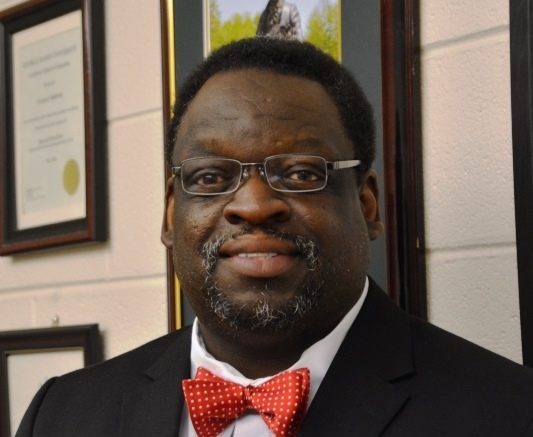By Caroline Fox
Gregory Baldwin’s motto is “students don’t care how much you know until they know how much you care.” Baldwin, a T.C. graduate and former Dean of the Class of 2018, accepted a new position this year as the School Climate Specialist. The position, which is new to Alexandria City Public Schools (ACPS), involves providing support to schools; “this means implementing restorative practices and providing support and training for ACPS employees,” said Baldwin.
The restorative practice program includes three “tiers” of execution: the first is known colloquially as the community circle, used by all students and teachers to promote classroom unity. Tier two restorative circles, which include direct conflict resolution, are facilitated and led by administrators. Tier three circles, reserved for serious, suspendable offenses, are led by Baldwin and are known as restorative conferences. Restorative conferences may be used to gain closure after a student has been suspended.
A central aspect of restorative practices is the community circle–a collaborative, discussion-based tactic for students to express themselves. Baldwin’s most recent training session on October 12 at T.C. was called “How To Use Circles in the Classroom.” The effort to expand restorative practices has included a request from T.C. Principal Peter Balas that teachers use community circles at least once per unit in their classes.
Restorative circles are used to remediate conflicts and prevent the necessity of student suspension. A student who has committed an infraction may sit down with a school counselor, academy principal, parent, or another adult and have a discussion to target and address the root of the student’s problem. In nonviolent conflicts involving students or staff, restorative circles may be used to have an open dialogue and solve a conflict without resorting to suspension. When it comes to more serious infractions like fighting and substance use, it may be necessary for the T.C. administration to issue a suspension to preserve the order and safety of the school. However, a restorative circle or conference may follow after the student returns to school.
Baldwin said that, “like any practitioner, you want to know what the best practice is to ensure everyone is successful. Community circles are a tool that staff can have in their toolbox and use to increase positive behavior.
The implementation of restorative practices also includes an emphasis on cultural competency. “We need to look at biases when suspending students,” said Baldwin. “We want to make sure that when we suspend students that we are aware of our biases when we do it; research suggests that there are some biases when it comes to giving out consequences. There has to be a focus on equity and making sure that everyone receives what they need.”
“There is a disproportionality across the nation where students of color are suspended three to four times more than their counterparts,” said Baldwin. “Restorative practices have proven to be effective in decreasing these suspensions and expulsions. Suspensions should be a last resort, never the first intervention for a student who has engaged in an infraction.”
According to Baldwin, a School Climate Specialist is even more necessary now than in previous years because unfortunately, “We are still seeing an increase in suspensions, expulsions and school violence. When we talk about how to bring about positive change, it starts with the climate, culture and environment that we live in. It’s imperative to identify tools and strategies to continue developing and promoting a good environment.”
Baldwin acknowledges that the increasing size of the T.C. student population makes it a challenge to handle student discipline. “When I graduated, we were challenged, but not like we are now. However, I do support Principal Balas’ desire to divide the system into academies. When I was a dean, I had over 800 students, but with this new framework the administrators have significantly less students to manage.”
In addition to its role in preventing student suspensions, restorative practices also aim to increase student achievement in the classroom. “It’s about how you use the circles,” said Baldwin. “You can also use them for delivering the instruction. They can be used to support the curriculum–we are consistently finding new ways to use them.” The goal of community circles is to develop a sense of cooperation and tolerance between students and teachers so classroom instruction becomes more cohesive.
Baldwin has trained a group of 30 T.C. students to help conduct community circles in their classes. The group was made up of students who had previously been involved in community and restorative circles. “Students must buy into this for it to be effective, since the overall goal is to increase student voices and achievement–we want this to become a part of our culture,” said Baldwin.
Although this is the fourth year of using restorative practices at T.C., “last year was the first year we really attempted to use it with fidelity,” said Baldwin. The administration has made an effort to provide designated areas within the school where restorative circles can be held.
“There is a five year articulation plan to implement the restorative practice into [elementary and middle] schools,” said Baldwin. The plan started with T.C. Williams, and the middle schools will start using restorative practices next year. Eventually, elementary schools will also begin to apply restorative practices. “Positive behavioral interventions and supports are big in elementary schools, and they work hand in hand [with restorative practices],” said Baldwin.
“If a child does not behave, there has to be social and emotional teaching that takes place and restorative practices allow that,” said Baldwin. “We all have learned behaviors so there has to be a focus on being well behaved, productive members of society.”

